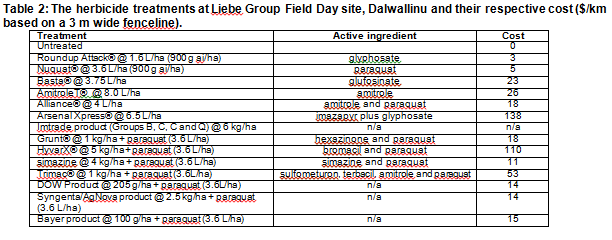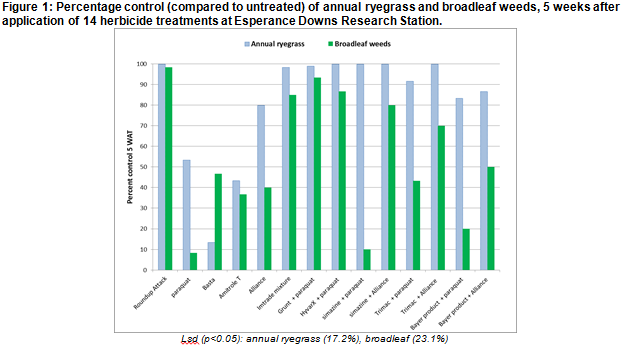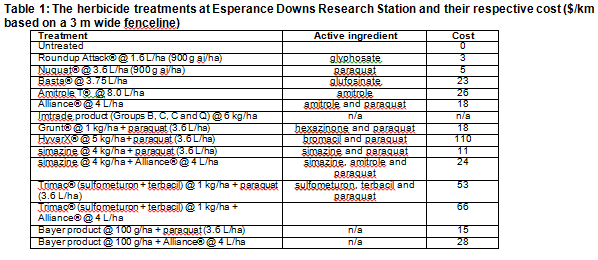Control weeds in your fence lines and stop herbicide resistance spread
Author: Sally Peltzer and Members of the Esperance and Northern Advisor Groups | Date: 20 Mar 2013
Key Messages
- Effective herbicide options other than glyphosate are available to control weeds along fence lines and in non-crop areas.
- Glyphosate may be cheap in comparison to other herbicide options but there is an increased risk of developing glyphosate resistance with sustained applications. This will lead to subsequent greater costs.
- Knockdown herbicides alone have shown good initial control however later germinations reduce their effectiveness.
- A knockdown herbicide plus a residual give flexibility of management – farmers are not restricted to applying herbicides before the season break.
Aims
Annual ryegrass is a major weed across Western Australia and the number of glyphosate resistant populations is increasing (82 out of the documented 347 sites with glyphosate resistant annual ryegrass in Australia are from fence lines). Weeds that grow on fence lines can move into cropping fields taking their resistance status with them and so their management is imperative (Preston, 2010). This study was designed to explore alternatives to glyphosate to control annual ryegrass in fencelines and remind growers to prevent the onset of resistance on their properties.
Method
A GRDC-funded herbicide resistance project (UA00124) was designed to help growers understand and manage glyphosate resistance (as well as resistance to paraquat and phenoxies). Part of this project, included the establishment of advisor ‘learning groups’. There are two in WA:
- The Esperance Group includes Eric Nankivell (Farmanco), Phil Smyth (Farmanco), Quenten Knight (Precision Agronomics), Theo Oorschott (Esperance Rural Supplies), John Richardson (Reed, Richardson and Assoc.), Brad Johnson (Nufarm), Peter Roberts (GRDC), Greg Curnow (SEPWA), Chris Reichstein (SEPWA), Ben Curtis (DAFWA) and Sally Peltzer (DAFWA).
- The Northern Group includes David Cameron (Farmanco), Geoff Fosbery (Consultag), Peter Bostock (Landmark), Helen Lethlean, Chris Wilkins (Vision Agribusiness), John Even (GRDC), Richard Quinlan (Planfarm), Erin Cahill (Agvivo), Bevan Addison, Peter Newman (DAFWA), Sally Peltzer (DAFWA), Abul Hashem (DAFWA), Rick Horbury (Bayer), Paul Chatsfield (Syngenta), Bill Campbell (Nufarm), Melissa Welsh (DOW), Clare Johnston (Liebe Group) and Chris O’Callaghan (Liebe Group).
Both groups decided to explore alternatives to glyphosate in fencelines in 2012. They chose to compare 13 herbicide treatments (applied as either single knockdown herbicides (paraquat, Amitrole® T, glufosinate or Alliance®) or as a mixture of a residual herbicide and a knockdown (paraquat or Alliance®) with glyphosate.
Trail 1 - Esperance Downs Research Station (EDRS)
The first fenceline trial was located at Esperance Downs Research Station (-33.646320, 121.810837) with 500 mm annual and 304 mm growing season (April to October) rainfall in 2012 on sandy gravel duplex soil. The site was dominated by glyphosate-susceptible annual ryegrass (Lolium rigidus), barley grass (Hordeum leporinum), a mixture of brome grass (B. hordaceus and diandrus), capeweed (Arctotheca calendula), subclover (Trifolium subterraneum), and some mallow (Malva parviflora) and erodium (Erodium botrys). Fourteen herbicide treatments were applied with Agrotop Airmix 110/03 nozzles at 8 kph with a water rate of 157 L/ha using 300 kPa pressure on 9 August 2012. Visual assessments (percentage control compared to untreated) were made 20, 33 and 82 days after herbicide application. This trial was a randomised split-plot design with three replicates.
Trial 2 - Liebe Group Main Trial Site, Dalwallinu
The second fenceline trial was located at the Liebe Group’s Main Trial Site for 2012 on the Mills’ property, 15km east of Dalwallinu on Monks Road (-30.288486,116.828543) with 229 mm annual and 132 mm growing season (April to October) rainfall in 2012 on sandy loam soil. The site was dominated with glyphosate-susceptible annual ryegrass and wild radish (Raphanus raphanistrum) with some capeweed. Fourteen herbicide treatments were applied with Teejet AIXR11002 nozzles nozzles at 6 kph with a water rate of 160 L/ha using 360 kpa pressure on 3 August 2012. Visual assessments (percentage control compared to untreated) were made 20 and 41 days after herbicide application. This trial was also a randomised split-plot design with three replicates.

Results
Trail 1 - Esperance Downs Research Station (EDRS)
Knockdown herbicides (paraquat, Basta® and Amitrole T®) applied alone tended to perform poorly compared with residual herbicide mixes due to the large size of the weeds at the time of spraying (Figure 1, p<0.05). While Basta® gave better control of broadleaf weeds, grass control was poor. Glyphosate provided good control as the annual ryegrass population was glyphosate susceptible at this site.
The residual herbicides (hexazinone, bromacil, terbacil and simazine tank-mixed with paraquat or Alliance®) gave very high levels of annual ryegrass (p<0.05) and barley grass (data not shown) control. Mixes with Alliance® gave higher levels of control, especially of the broadleaf weeds, compared with mixes with paraquat (p<0.05). The amitrole in the Alliance® gives superior control of larger weeds as it is translocated, although it takes three to five weeks to show significant symptoms.
The Imtrade firebreak mix gave good control after 5 weeks but was slow to start (the assessment after 3 weeks showed poor control). This suggests it needs significant rain before it starts to kill the weeds indicating low solubility.
A further assessment of the trial on 1 November 2012 (82 days after application), showed substantial new growth (and summer weeds) on the knockdown treatments (glyphosate, paraquat, Basta® and Amitrole T®) while the residual herbicide treatments and the Imtrade firebreak mix maintained good control.

Trial 2 - Liebe Group Main Trial Site, Dalwallinu
Despite a prolonged dry period prior to trial commencement, the residual herbicides (tank-mixed with paraquat) gave very high levels of control (Figure 2, p<0.05).
Arsenal® Xpress gave good control of ryegrass and radish along with Trimac® + paraquat, hexazinone + paraquat and bromacil + paraquat. Arsenal® Xpress is composed of glyphosate and imazapyr, a Group B herbicide, so resistance status needs to be closely monitored. Imazapyr and hexazinone can also be dangerous to trees and shrubs so they will not suit these situations.
Knockdown herbicides applied alone gave slightly lower levels of control at six weeks after treatment. Paraquat and glyphosate were applied at equivalent rates of active ingredient and gave equivalent control. Basta® performed better at Dalwallinu compared with Esperance, due to the higher temperatures experienced.

Conclusion
Tank mixes of residual herbicides plus either paraquat or Alliance gave the best control of both annual ryegrass, wild radish and other grasses and broadleaf weeds at both Esperance and Dalwallinu.
Each herbicide treatment has disadvantages associated with them. Knockdown herbicides alone risk later germinations of the weeds and glufosinate (Basta®) is temperature dependent. Some residual herbicides (such as hexazinone) are highly soluble and have a high risk for leaching down the profile and moving away from the area of application. A lower solubility herbicide (like simazine) needs more rain to move into the root zone. Arsenal Express is a mixture of glyphosate and a MOA Group B herbicide increasing the risk of resistance development. Other herbicide treatments can be very effective but are expensive.
It is recommended to use a knockdown herbicide (other than glyphosate) plus a residual. This will give flexibility to the timing of application and provide alternatives to glyphosate, reducing the risk of glyphosate resistance which could become costly in the long-run.
References
C. Preston (2010) Managing resistance on fencelines and crop margins.
Acknowledgments
I would like to thank both ‘Teams’ for all their input into this trial and GRDC for the funding.
GRDC Project No.: UA00142
Paper reviewed by: John Moore
Was this page helpful?
YOUR FEEDBACK

